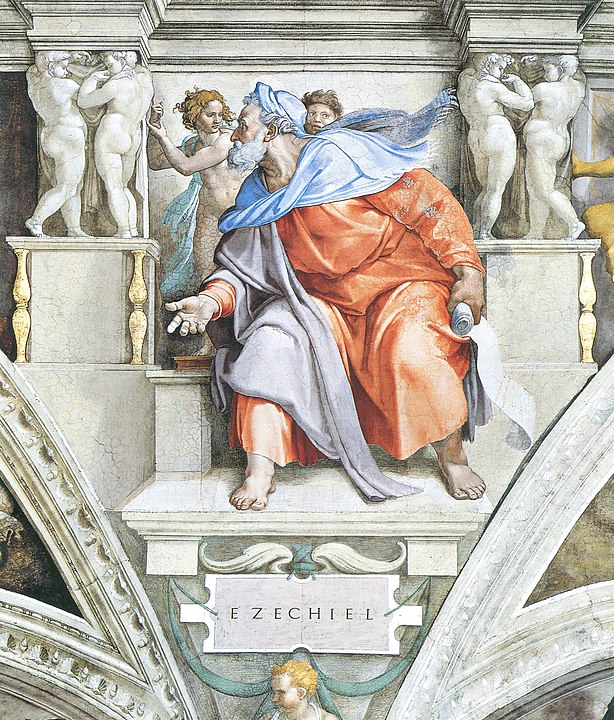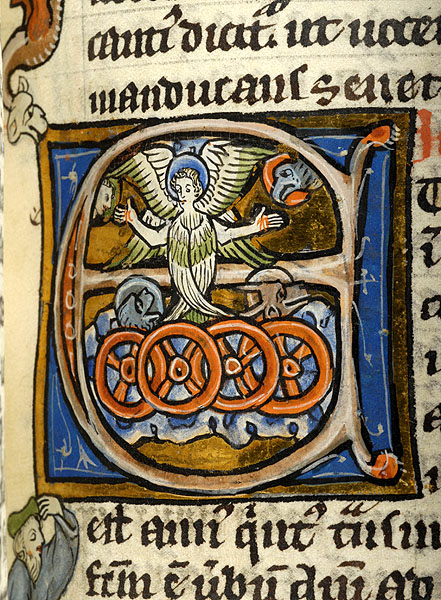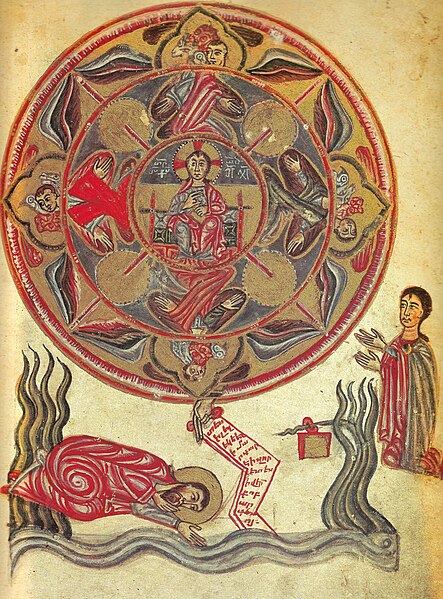The Prophet Ezekiel
Opening Shots
- Ezekiel's vision took place in the early 6th century BCE, during the Babylonian exile.
- The key event is described in Ezekiel 1:1, where Ezekiel mentions that he was among the exiles by the Kebar River
- King Nebuchadnezzar II conquered the southern kingdom of Judah. This culminated in the destruction of Jerusalem and the First Temple in 586 BCE and led to the Babylonian exile of the Jewish people, including Ezekiel
- Ezekiel was part of the first group of Jewish exiles taken to Babylon in 597 BCE
- The visions of Ezekiel are really complex and marvelous
- The figures with the four faces man . lion , eagle and ox
- How did this vision evolve into the tetramorph?
- Moves on to describe the "Chariot of God" of fire?
When did the deportations take place?
First Deportation (circa 597 BCE)
This occurred after King Nebuchadnezzar II of Babylon besieged Jerusalem during the reign of King Jehoiakim of Judah. Jehoiakim's son, Jehoiachin, surrendered, and he, along with the royal family, nobles, and many skilled workers, were taken to Babylon. This is when Ezekiel was likely exiled.
Second Deportation and the Fall of Jerusalem (586 BCE)
In response to continued rebellion in Judah, Nebuchadnezzar returned and destroyed Jerusalem, including the First Temple, and deported a much larger number of people to Babylon. This event marked the most significant phase of the Babylonian exile.
Further Deportations
After the fall of Jerusalem, further smaller-scale deportations occurred, especially after subsequent rebellions against Babylonian rule.
Duration of the Exile
The exile is traditionally considered to have lasted about 70 years, ending with the Persian conquest of Babylon in 539 BCE, when Cyrus the Great allowed the Jewish exiles to return to Jerusalem and rebuild the Temple (which became known as the Second Temple).
Summary
So, the Babylonian exile was a prolonged process, starting with initial deportations around 597 BCE and continuing through the destruction of Jerusalem in 586 BCE, and was finally resolved with the return from exile starting in 538 BCE.
Who was Ezekiel preaching to?
Audience
Ezekiel's primary audience was the Jewish community in exile in Babylon. These were people who had been taken from Judah, including Jerusalem, in the earlier deportations, and were now living as captives in a foreign land. His messages addressed their situation, including their spiritual condition, the reasons for their exile, and the need for repentance.
Prophetic Messages
Judgment on Jerusalem
While Ezekiel was in Babylon, he received visions and prophecies about the coming destruction of Jerusalem and the Temple (which had not yet happened when he began his ministry). He communicated these warnings to the exiles, telling them that the destruction was a consequence of the people's sins and idolatry.
Hope for Restoration
After the fall of Jerusalem, Ezekiel's messages shifted to offering hope for the future, including the promise of eventual restoration, the return to the land of Israel, and the rebuilding of the Temple.
Symbolic Actions
Ezekiel often conveyed his messages through dramatic symbolic actions (like lying on his side for extended periods or cooking food over dung) to illustrate the severity of the judgment on Jerusalem and to capture the attention of the exiles.
Role in the Exilic Community
Ezekiel's role was to keep the exiles spiritually informed and connected to God's ongoing plan, despite being far from their homeland. His prophecies were intended to encourage the exiles to remain faithful to God, even in difficult circumstances, and to prepare them for eventual return and restoration.
Summary
In summary, Ezekiel's prophetic mission was focused on the Jewish exiles in Babylon, warning them of the impending judgment on Jerusalem and later offering them hope for the future restoration of Israel. His prophecies were a vital part of maintaining the faith and identity of the Jewish people during the Babylonian exile.
Ezekiel's vision of God's chariot and the detail of the Wheels
The Vision of the Wheels (Ezekiel 1:15-21)
In Ezekiel 1, the prophet has a vision of a divine chariot, often called the "Merkabah" (a term later used in Jewish mysticism). The vision includes four living creatures, each with four faces (man, lion, ox, eagle) and four wings. Beside each creature is a wheel, and these wheels are described in detail.
Description of the Wheels
Appearance of the Wheels
- The wheels are described as having "the appearance of beryl" (a bright, gleaming gemstone).
- Each of the four living creatures has a wheel beside it.
- The wheels are described as "a wheel within a wheel," which might suggest concentric or interlocking wheels that could move in any direction without turning.
Movement of the Wheels
- The wheels are capable of moving in any direction, corresponding to the movement of the living creatures. They do not need to turn as they move, implying multidirectional mobility.
- The wheels and the living creatures are perfectly synchronized—when the creatures move, the wheels move; when the creatures rise, the wheels rise as well.
Eyes on the Wheels
- The rims of the wheels are described as being full of eyes all around. This detail emphasizes awareness, perception, and possibly divine omniscience.
Symbolic Significance

Figure 3: The Prophet Eziekiel - Sistine Chapel
Divine Mobility and Presence
- The wheels suggest that God's presence is not confined to one place (like the Temple in Jerusalem) but is mobile and can go anywhere. This would have been a significant message for the exiles, who were far from their homeland and the Temple.
- The "wheel within a wheel" design implies that God's chariot can move freely in any direction, symbolizing that God's power and authority are not limited by geographical or physical constraints.
Omniscience and Omnipresence
- The eyes on the wheels symbolize God's all-seeing nature, representing His omniscience. God is aware of everything happening everywhere, whether in heaven or on earth, whether in Jerusalem or in exile.
- The wheels' movement in perfect harmony with the creatures indicates that God's will is perfectly executed, and His presence is with the living creatures, symbolizing the active and living nature of God.
Connection to the Four Living Creatures
- The living creatures and the wheels together form a divine chariot, with the creatures representing different aspects of creation (man, lion, ox, eagle) and possibly different qualities (wisdom, majesty, strength, swiftness).
- The wheels show that this chariot is driven by God's will, reinforcing the idea that God's spirit is the force behind all movement and action in the universe.
God's Sovereignty
- The vision as a whole emphasizes God's sovereignty over all creation. The chariot is a symbol of royal authority, and in this vision, it shows that God is the true king, ruling over all the earth and not bound by human-made structures or borders.
What is Going On
In the vision, Ezekiel sees the glory of God manifested in a highly symbolic, almost otherworldly form. The wheels and living creatures together symbolize the majesty, omnipotence, and omnipresence of God. This vision was meant to reassure the exiles that God was still with them, even though they were far from Jerusalem. It also served to remind them of God's ultimate power and authority, which transcends any earthly kingdom or power.
Summary
- Wheels
- Represent God's omnipresence and ability to move and act anywhere in the universe.
- Eyes
- Symbolize God's omniscience, seeing and knowing all things.
- Movement
- Reflects the sovereignty of God's will, which is active and pervasive.
- Living Creatures and Chariot
Represent the idea that all creation is under God's control and that His divine presence is not confined to one location.
Ezekiel's vision, therefore, is a powerful and complex depiction of God's presence and power, meant to comfort and challenge the Jewish exiles in Babylon, reinforcing the idea that God is with them no matter where they are.
The fall of Jerusalem: Ezekiel 33:21-22
The City has fallen!
Context and Explanation
Timeline and Historical Context
The passage mentions "the twelfth year of our exile," which likely refers to the exile of King Jehoiachin and the first major deportation to Babylon around 597 BCE. The "twelfth year" would then place this event around 586 BCE, which is indeed the year Jerusalem was destroyed by the Babylonians.
Literal Fall of Jerusalem
- The phrase "The city has fallen!" in this context is indeed referring to the literal and historical fall of Jerusalem. This was the culmination of the Babylonian siege that resulted in the destruction of the city and the Temple, a catastrophic event in Jewish history.
- The news being delivered to Ezekiel about the fall of Jerusalem is not metaphorical. It signifies the actual military defeat and the destruction of Jerusalem by the Babylonian army under King Nebuchadnezzar II. The fall was a decisive event that marked the end of the Kingdom of Judah as an independent state.
Ezekiel's Response
The passage also describes Ezekiel's response to the news. His mouth being "opened" signifies the end of his period of prophetic silence, which was a symbolic act related to his mission. God had told Ezekiel earlier that he would be silent until the news of the fall of Jerusalem reached him (Ezekiel 24:27). With the city's fall, Ezekiel's role as a prophet takes on a new dimension, focusing on the aftermath and the hope for future restoration.
Significance
The fall of Jerusalem was a profound event that had been prophesied by Ezekiel and other prophets as a consequence of the people's disobedience and idolatry. This news would have confirmed Ezekiel's prophecies to the exiles in Babylon and marked a turning point in his ministry.
Conclusion
The passage in question is not metaphorical but is a literal reference to the fall of Jerusalem in 586 BCE. It aligns with the historical timeline of the Babylonian conquest and the significant events that followed, which Ezekiel had been prophesying about. The news of Jerusalem's fall, as reported to Ezekiel, confirmed the fulfillment of these prophecies and set the stage for his subsequent messages, which included both judgments and promises of future restoration.
Non-biblical evidence for the Babylonian Exile
Babylonian Chronicles:
The Babylonian Chronicles are a series of tablets that record the history of the Neo-Babylonian Empire. These chronicles provide a year-by-year account of events, including military campaigns, astronomical observations, and significant political events. Nebuchadnezzar II's Campaigns: The ch

